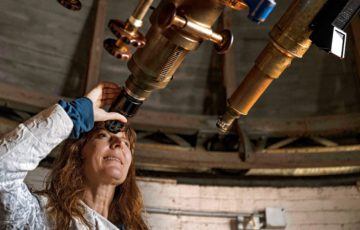Joshua Sokol in Quanta Magazine:
 One of the many times Lisa Kaltenegger’s dream jolted a little closer toward reality was on a cold April morning a decade ago at an astronomy conference. She was clutching what she recalls was a terrible, just awful cup of coffee, not because she was going to drink any more of it but because she had waited in line and it was warm in her hands. Then Bill Borucki veered in her direction.
One of the many times Lisa Kaltenegger’s dream jolted a little closer toward reality was on a cold April morning a decade ago at an astronomy conference. She was clutching what she recalls was a terrible, just awful cup of coffee, not because she was going to drink any more of it but because she had waited in line and it was warm in her hands. Then Bill Borucki veered in her direction.
She readied herself to tell him to avoid the coffee. But Borucki, head of NASA’s Kepler mission, a space telescope designed to hunt for planets orbiting other stars (or “exoplanets”), had something else to discuss. Kepler had glimpsed its first two Earth-size exoplanets with a decent chance of having liquid water on their surfaces. These were the sort of strange new worlds that everyone at the conference — and possibly most of the human race — had imagined at least once. Would Kaltenegger confirm that the planets might be habitable?
Kaltenegger, at the time an astrophysicist at the Max Planck Institute for Astronomy in Heidelberg, Germany, started running new climate models before the conference was over, incorporating basic facts like the planets’ diameters and the lukewarm glow of their star. Her ultimate answer: a qualified yes. The planets might be suitable for life, or at least for liquid water; they could even be water worlds, encased in endless oceans without a single rocky outcrop poking above the waves. The caveat was that she would need more advanced observations to be sure.
More here.
